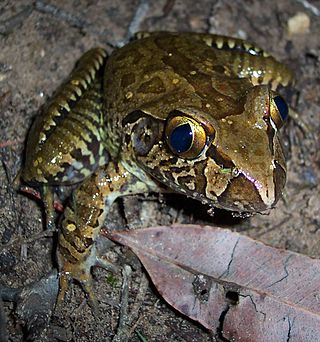
Conondale National Park is 130 km north of Brisbane in the Sunshine Coast Hinterland near the town of Conondale in the south east Queensland bioregion. The park covers an area of 35,648 hectares protecting large areas of subtropical rainforest, woodlands, wet and dry sclerophyll forest including Queensland's tallest tree. The park contains areas of regenerating forest which have been previously logged; areas of forest plantations also border the park. The park is currently managed by the Queensland Government under the Nature Conservation Act 1992.

Buttonquail or hemipodes are members of a small family of birds, Turnicidae, which resemble, but are not closely related to, the quails of Phasianidae. They inhabit warm grasslands in Asia, Africa, Europe, and Australia. There are 18 species in two genera, with most species placed in the genus Turnix and a single species in the genus Ortyxelos.

The barred buttonquail or common bustard-quail is a buttonquail, one of a small family of birds which resemble, but are not closely related to, the true quails. This species is resident from India across tropical Asia to south China, Indonesia and the Philippines.

The common buttonquail, also called Kurrichane buttonquail, small buttonquail, or Andalusian hemipode is a buttonquail, one of a small family of birds which resemble but are not closely related to the true quails.

The painted buttonquail is a species of buttonquail, the family Turnicidae, which resemble, but are unrelated to, the quails of Phasianidae. This species is resident in Australia where numbers are believed to be in decline. A subspecies, the Abrolhos painted buttonquail, is endemic to the Houtman Abrolhos islands.

The king quail, also known as the blue-breasted quail, Asian blue quail, Chinese painted quail, or Chung-Chi, is a species of Old World quail in the family Phasianidae. This species is the smallest "true quail", ranging in the wild from southern China, South and Southeast Asia to Oceania, south to southeastern Australia, with 9 different subspecies. A failed attempt was made to introduce this species to New Zealand by the Otago Acclimatisation Society in the late 1890s. It is quite common in aviculture worldwide, where it is sometimes misleadingly known as the "button quail", which is the name of an only very distantly related family of birds, the buttonquails.

The little buttonquail is a species of buttonquail, part of a small family of birds which resemble, but are unrelated to, the true quails. This species is resident in Australia, where it is one of the more common buttonquails.
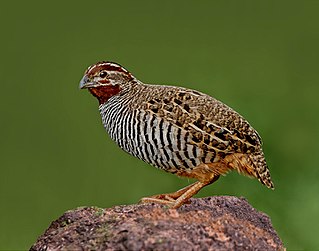
The jungle bush quail is a species of quail in the family Phasianidae. It is native to the Indian subcontinent, where it is found in peninsular India and Sri Lanka. It has also been reported from Nepal but has not been seen there since the 19th century, and an introduced population exists on the island of Réunion. A small species of quail 15–18 cm (5.9–7.1 in) long and weighing 57–82 g (2.0–2.9 oz), it shows significant sexual dimorphism. Males have brown upperparts with blackish and buff marking and whitish underparts with black barring. The face is mainly dark reddish-brown, with brown ear-coverts, a buffy-white moustachial stripe, and the supercilium turning whitish towards the back of the neck. Females have a similar pattern, but with pinkish-brown underparts, more uniform wings, and duller moustachial stripes.

The yellow-legged buttonquail is a buttonquail, one of a small family of birds which resemble, but are unrelated to, the true quails. This family is peculiar in that the females are larger and more colourful than the males and are polyandrous.

The black-breasted buttonquail is a rare buttonquail endemic to eastern Australia. As with other buttonquails, it is unrelated to the true quails. The black-breasted buttonquail is a plump quail-shaped bird 17–19 cm (6.7–7.5 in) in length with predominantly marbled black, rufous, and pale brown plumage, marked prominently with white spots and stripes, and white eyes. Like other buttonquails, the female is larger and more boldly coloured than the male, with a distinctive black head and neck sprinkled with fine white markings. The usual sex roles are reversed, as the female mates with multiple male partners and leaves them to incubate the eggs.
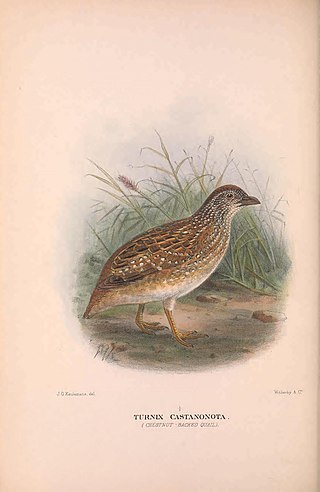
The chestnut-backed buttonquail is a species of bird in the family Turnicidae. It is endemic to Australia.

The red-backed buttonquail is a species of bird in the family Turnicidae. It is found in Australia, Indonesia, Papua New Guinea, the Philippines and the Solomon Islands. Other names by which it is known in different parts of its range include black-backed, black-spotted and orange-breasted buttonquail. There are fourteen recognised subspecies.

The red-chested buttonquail is a species of bird in the family Turnicidae. It is endemic to Australia. The species is generally regarded as widespread, although uncommon, in New South Wales, Queensland, northern Western Australia and the Northern Territory, and classified as Vulnerable in Victoria.
The Luzon buttonquail or Worcester's buttonquail, is a species of bird in the family Turnicidae. It is endemic to the island of Luzon in the Philippines. Its natural habitat is tropical high-altitude grassland. This is the most mysterious bird of Luzon as there has only been 1 sighting in 2009 of a trapped individual being sold for bushmeat.

The chestnut-breasted quail-thrush is a small endemic Australian bird which is predominantly found within the semi-arid deserts of New South Wales and Queensland.

The chestnut quail-thrush is a native Australian bird of the family Cinclosomatidae. These scrub birds are endemic to Australia and found in all states - barring Tasmania. They are relatively uncommon and are isolated to the semi-arid and arid fringes of the Australian interior.
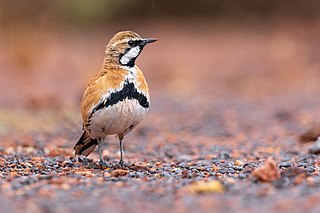
The cinnamon quail-thrush is a small to medium-sized species of bird that is endemic to Australia. This bird is found in the arid and semi-arid regions of central Australia.
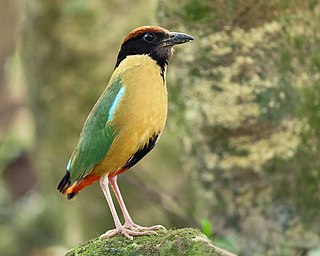
The noisy pitta is a species of bird in the family Pittidae. The noisy pitta is found in eastern Australia and southern New Guinea. It eats earthworms, insects and snails. Its natural habitats are temperate forests, subtropical or tropical moist lowland forest, and subtropical or tropical moist montane forest.

















